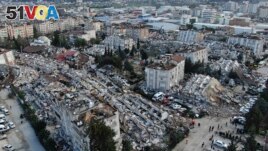07 February 2023
More than 6,200 people have been reportedly killed in the earthquake and aftershocks that struck Turkey and Syria on Monday. But officials warn that the number is likely to rise. Tens of thousands of people have also been injured.
In Turkey, President Recep Tayyip Erdogan declared a state of emergency in 10 affected provinces for three months. Rescue workers are struggling with difficult conditions and low temperatures.
Erdogan said more than 3,500 people have died in Turkey.

Aerial photo shows the destruction in Hatay city center, southern Turkey, Feb. 7, 2023. (IHA via AP)
Turkey's Disaster and Emergency Management Authority (AFAD) said 5775 buildings had been destroyed and more than 20,426 people had been injured. The government plans to open hotels in Antalya, a place popular with foreign visitors, to temporarily house people displaced by the quake.
On Tuesday, a large fire was still burning at the southern port of Iskenderun. Pictures from Hatay showed many tall housing buildings had collapsed, suggesting that the number of dead might be much higher.
It is feared that many remain trapped under collapsed buildings. One man told Reuters, "They're making noises but nobody is coming...They're calling out. They're saying, ‘Save us' but we can't save them..."
From Geneva, the United Nations children's agency said it fears: "The earthquakes...may have killed thousands of children."
In Syria, the government news agency SANA said more than 812 people had died in government-controlled areas. In the rebel-held northwest, a rescue group called the White Helmets said at least 900 had died. The leader of the group said it is making efforts but it was unable to deal with a large number of collapsed buildings.
What kind of earthquake was it?
The U.S. Geological Survey (USGS) said the 7.8 magnitude quake was centered in southern Turkey, near the border with Syria. Many smaller earthquakes, or aftershocks, followed the first. And, nine hours after the first quake, another 7.5 magnitude earthquake hit. Alex Hatem is a USGS geologist. He said, "More aftershocks are certainly expected, given the size of the main shock."
Researchers say that the earthquake was a strike-slip quake. These result when two huge pieces of the Earth's surface, called tectonic plates, slide past each other. Tension builds up between the pieces of the Earth's crust until the energy is released in the form of an earthquake.
In this case, one plate moved west while the other moved east, Hatem said. The aftershocks will slowly lessen over time.
Monday's earthquake in Turkey was very powerful for one that was centered on land. Usually, such strong quakes take place under the sea, said Margarita Segou of the British Geological Survey.
Why was the quake so damaging?
The quake hit near Gaziantep, a major city and provincial capital in Turkey. Kishor Jaiswal, a USGS structural engineer, said the area has a lot of vulnerable buildings.
He said new buildings in cities like Istanbul were designed to withstand earthquakes. But many older, tall buildings are not. Also, in Syria, fast building methods and years of war have left many structures weakened.
Officials say thousands of buildings have collapsed, including "pancake" collapses in which upper floors fall straight down onto lower floors. That is a sign that the structures were not built well.
Rescuers have also been slowed by freezing temperatures and traffic as people flee affected areas.
The quake was Turkey's deadliest since the 1999 Izmit earthquake. In 2011, a powerful 7.2 magnitude quake struck southeastern Turkey killing 600.
I'm Mario Ritter, Jr.
Mario Ritter, Jr. adapted this story for VOA Learning English from Associated Press and Reuters sources.
_____________________________________________________________________
Words in This Story
Words in This Story
magnitude –n. a measure of the power of an earthquake
tectonic plate –n. an extensive part of the surface of the Earth which moves in relation to other parts causing earthquakes and volcanoes
crust –n. the outer part of the Earth's surface
vulnerable –adj. able to be harmed; in danger of damage or destruction